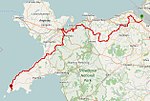St Winefride's Halt railway station
Disused railway stations in FlintshireFormer London and North Western Railway stationsPages with no open date in Infobox stationRailway stations in Great Britain closed in 1954Railway stations in Great Britain opened in 1912 ... and 2 more
Use British English from November 2022Wales railway station stubs
St Winefride's Halt railway station was a station in Holywell, Flintshire, Wales. The station was opened on 1 July 1912 and closed on 6 September 1954. Situated on a bend there was a curved wooden platform with just the name board and gas lighting. There was a siding running behind the platform at a lower level to serve local industries. There are no remains of the halt today.
Excerpt from the Wikipedia article St Winefride's Halt railway station (License: CC BY-SA 3.0, Authors).St Winefride's Halt railway station
Greenfield Road,
Geographical coordinates (GPS) Address Nearby Places Show on map
Geographical coordinates (GPS)
| Latitude | Longitude |
|---|---|
| N 53.2779 ° | E -3.2218 ° |
Address
Greenfield Road
Greenfield Road
CH8 7PN , Holywell
Wales, United Kingdom
Open on Google Maps






